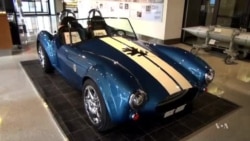Cars with parts made by 3-D printers are already on the road, but engineers are still learning about this new technology. While testing the possibility of printing an entire car, researchers at the U.S. Department of Energy recently created an electric-powered replica of an iconic sports roadster.
AC Cobra, also known as Ford/Shelby Cobra, is an Anglo-American, two-seater sports car, manufactured intermittently since 1962. It competed in a number of road races but, because it was so expensive, it never sold in large numbers.
Attempting to bring it back as a retro sports car, Ford unveiled a modernized version at the Detroit Auto show in 2004.
Researchers at the U.S. Department of Energy recently displayed yet another version, this time with electric propulsion and a plastic body printed in a 3-D printer.
Robert Ivester of Energy's Advanced Manufacturing Office says the goal wasn't to build a Cobra. Instead, researchers wanted a way to test several things relevant to printing large-scale objects.
“The capability to balance thermal loads was an important one, the ability to achieve very, very high-quality, professional-grade surface finish, the ability to custom design around components that we were going to put in. So, this example has one motor and battery but we could relatively easily change over to a completely different motor and battery, power train, suspension system, because of 3-D printing," said Ivester.
The flexibility of 3-D printing proved to be a great advantage. Ivester says the car was built in six weeks by a group of six people at the Oak Ridge National Laboratory, in Tennessee.
"It’s printed in about six pieces – there's one piece that's the core chassis and mechanical structure. And the front end and the back end of the body were each produced in a couple of pieces that were joined to each other and then bolted on to the chassis," he said.
During tests at the National Transportation Research Center, the car reached 128 kilometers per hour, with acceleration of about eight seconds to 100 kmh. Not quite as fast as cars on the road today but respectable. The real value of 3-D printing is its speed, and versatility.
One of the most important advantages of large-scale 3-D printing for the automotive industry could be the manufacture of molds and dies for sheet metal car body parts, usually a critical production bottleneck.
“With a metal mold they’re going to start from a monolithic metal block and machine away all the pieces that they don’t need. And the finishing process just takes long. So the typical response time for an automotive scale mold is at least nine months. And we can do it in 48 hours with printing," said Ivester.
Ivester says his department is now researching whether 3-D printing of molds and dies could be used to build parts for wind turbines.






